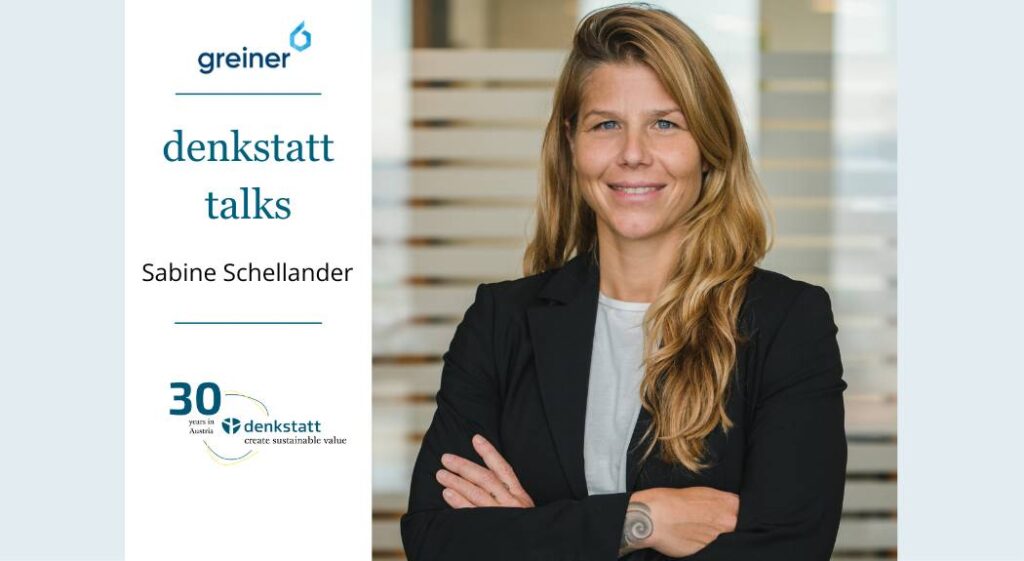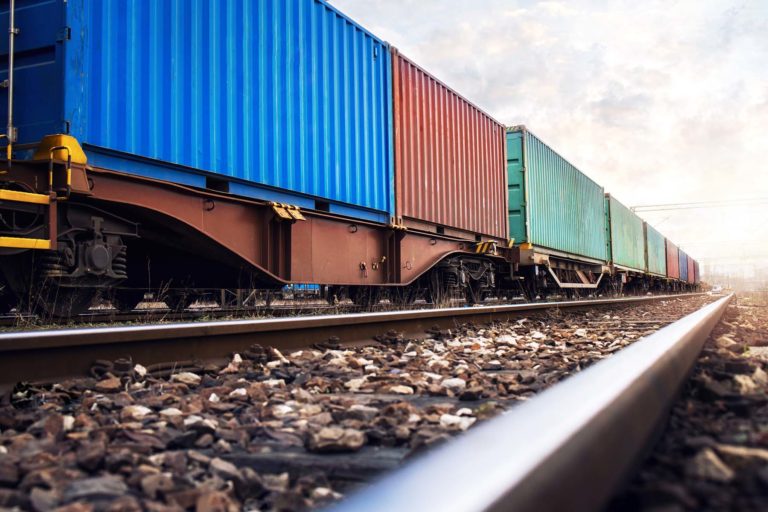Sabine Schellander, Co-Head of Sustainability at Greiner, can look back on more than 14 years of sustainability experience. What makes her stand out as a person is her broad networking and multifaceted commitment – whether as a member of the CSR Circle or as a lecturer. In this interview, she talks about the importance of collaboration, but also about the challenges and success factors for sustainability managers. In addition to the sustainability journey of Greiner, she also formulates a clear appeal to everyone: We have to get going!
Dear Sabine, in all these years you have gathered a wealth of knowledge in sustainability consulting and, as a sustainability manager in the private sector, you have initiated many topics. Now that you are deeply involved in operations: How do you assess the status quo? Is the change already in full swing?
Sabine Schellander: I often find myself torn between the two. Some days I have the impression that a lot is going on – significantly more than before. The EU publishes one regulation after another, and that naturally increases the pressure. And that’s a good thing. But the question I ask myself is: Is that enough, and is that the only lever we have? At the end of the day, we still have a lot to do and are a long way from really solving the urgent issues.
Is this ambivalent feeling perhaps typical of the profession?
It’s a sentiment that you definitely know if you’ve been involved with sustainability for any length of time. In my 14 years, it hasn’t really changed. But I think it’s somewhat normal in the job and you have to learn to deal with it. The point is that there is never this moment where we as sustainability managers can say, “Now the job is done.” There can’t be. We basically have huge issues like climate change and the circular economy, or even the sustainable design of our supply chains, sitting at our desks. We’re not talking months here, but years. Despite all these aspects, the quality and depth of sustainability measures has already increased massively. For example, we now see much higher data quality in carbon footprint calculations or more and more companies having science-based targets. This all carries more weight than it used to, and that’s a good sign.
When you say depth is increasing, what does that mean for the chemical industry?
In the chemical industry, we are talking about two major issues. One is decarbonization, which is closely interwoven with the circular economy. The other major issue is collaboration. Once climate targets are set, we have to look at how we decarbonize. At the same time, we need to look at recycling materials or products and where we get secondary raw materials and what the costs are. For everything that goes beyond my own corporate boundaries, I need stakeholders, such as raw material suppliers or waste management companies. For issues like these, we need the entire value chain at the table, so to speak, and we will have to work closely together in the future. However, this also requires a change in thinking and the ability to open up one’s own boundaries.
How does this work at Greiner? What are your experiences and perhaps also best practices?
At Greiner, we are increasingly engaging in stakeholder dialog. We are trying to learn from each other and exchange ideas. I would say that the course has been set. We are already doing a lot and we know what our issues are that we need to address. Our climate targets were recently endorsed by the Science Based Targets initiative. We’re proud of that and it’s an important milestone for us. But we only create the impact through concrete actions, for example when we reduce scope 3 emissions. There are currently many individual projects and our big goal is to draw the concept of the circular economy across the entire product portfolio and company. We now need to work on this with various stakeholders.
How do you shape the collaboration and what challenges do you face there?
In the beginning, we usually seek dialogue, for example with suppliers or customers. We talk to each other and think about different approaches and possibilities for cooperation. It is important to learn from each other. Let’s take the example of the Product Carbon Footprint. In addition to close cooperation with product development, this also requires the necessary expertise for calculation and, of course, the primary data. These are just three of the many individual steps, most of which are more complex than the theory would suggest, but which, taken as a whole, produce the big picture. It simply takes time and something like “relationship management”. Often, you first make an impact and start working on the relationship. In a second step, you intensify your efforts and then, in the best case, you take real measures that help you reach your goal. It all takes a lot of tact and it’s a balancing act between being patient and being driven. I think that’s what the role of a sustainability manager is all about.
Sustainability as a dream job: Sustainability managers are very sensitive to the consequences of climate change and other challenges of our time. At the same time, they face difficult conditions. How do you manage to maintain your own balance and enjoyment of the job, and what tips can you give others?
You have to be a dreamer and a realist at the same time. Hold on to your vision and measure success by what is possible. Because every step forward is an important one, and for the job to be fun for a long time, we have to celebrate successes. Then networks and alliances are important for professional exchange. For certain issues, for example, you can look for a peer company that is already further along in this area. But personal networks are also helpful for the feeling of not being alone. Sometimes you need a kind of self-help group where you can talk about what’s on your mind. Another aspect is learning together, also within the company. That’s why, in addition to decarbonization and the circular economy, we have a third strategic pillar for sustainability at Greiner: people.
You’re also known for putting a big focus on the “S” in ESG. Which social aspects are the burning issues?
I think we also need to understand the “S” in the sense of collaboration. If I want to make a difference, especially with these big issues, I need innovative performance. Greiner has almost 11,600 employees. There is enormous potential lying dormant. We need to inspire people and generate ideas together. We must anchor sustainability as an integral part of our patterns of thought and action, in our daily work and decision-making processes. For this structural change, we need people. In addition, the “S” also includes classic topics such as health and safety, diversity and human rights.
What challenges do you face at Greiner and what factors favor change?
In our industry, the transformation from a linear to a circular system is very central, and that is no easy task. Everyone has to be on board. For example, suppliers and producers must drive forward the issue of recycling to make secondary materials available at all. This requires the appropriate starting material. This in turn depends on the disposal, collection and processing of the products. For this to work, we have to design the products in such a way that they are recyclable on the one hand and contain a high proportion of secondary materials on the other, without of course negatively affecting the product properties. When it comes to dimensions, it’s not enough for me to sit down with everyone. Everyone also has to do their homework and we have to agree on how to do it. Among other things, that means following uniform standards to ensure the comparability of data sets. What makes it much easier with all the difficulties is the commitment from the board, and additionally from the owner in our case.
In your view, what is the role of consulting in corporate sustainability goals and where will the journey go?
For me, sustainability consulting is a kind of safety net to ensure that we work according to the latest scientific findings and that the company is on the right track. For that, you need the external lens from time to time. Another point is that you can shorten paths through the consultants’ wealth of experience. As a sustainability manager, I can’t become deeply familiar with all the standards and topics. This in-depth specialized knowledge is provided to me by the consultants, and this will continue to develop strongly in the coming years. This in turn means that consultants will also have to specialize even more – in order to provide us with targeted support. In addition, consulting must always be one step ahead of us and be able to provide insights into what others are doing and how we as a company can learn from these experiences and take shortcuts. There’s going to be a lot of movement on that.
Speaking of the future: Where will the journey go in the next 30 years?
In 30 years, we will be in the year 2053. I studied in 1995 and that is a similar time span to 2023. Climate change was already an issue then. So was decarbonization. It just cannot take another 30 years now. I simply wish that everyone would really get started now, give it their all and work in a well-founded manner. At conferences, I keep hearing what people aren’t already doing. But all in all, in my opinion, we are simply moving too slowly. Then you hear statements like, you can’t move anything on your own. Consumers must rethink and change their purchasing behavior, suppliers have to become more favorable and offer the right solutions, otherwise, nothing will happen. It often seems as if responsibility is being shifted back and forth. Just the other day, I heard at a panel discussion that everyone wants to do it anyway, but the solutions are lacking. I see it differently. The solutions are on the table and sustainability always starts with us. We now must use all our ingenuity and apply it in the interests of sustainable development. We have managed to fly to the moon. So, can we please now pool all our resources, innovate and work together to tackle the big issues of our time? No more waiting for politics. No more waiting for others to go off or go ahead. My appeal to everyone is to get out of the queue and get going ourselves. We are brilliant as humanity. Let’s use this for the greatest challenge of our time.
Thank you for your clear words and the interview, dear Sabine.
Many thanks also from my side.
Foto Sabine Schellander: Copyright 2022 Greiner




